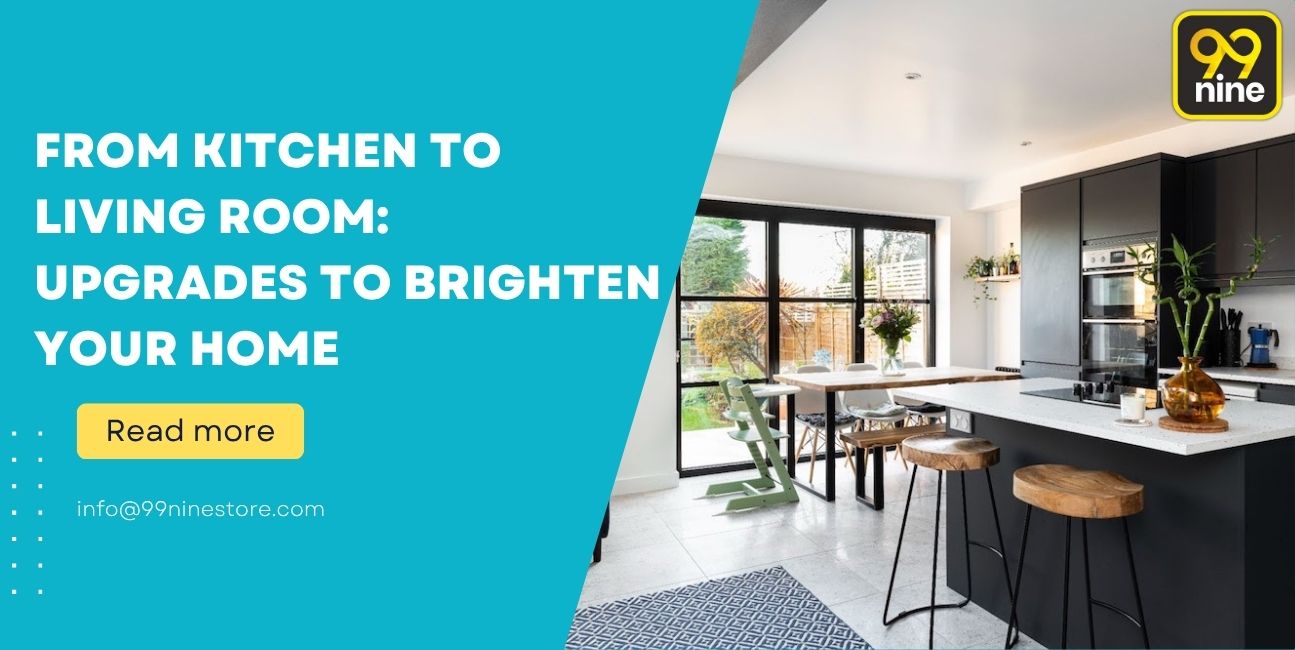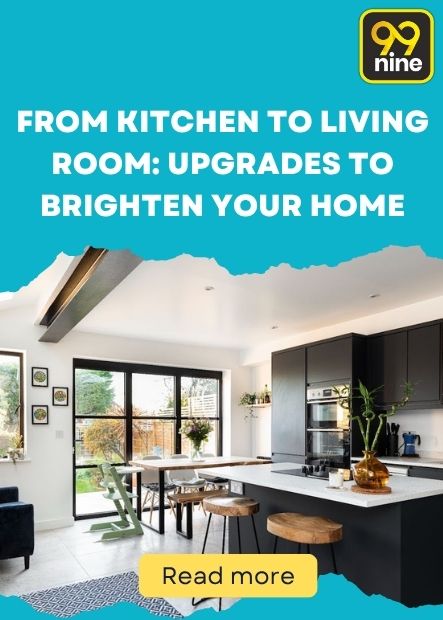

From Kitchen to Living Room: Upgrades to Brighten Your Home
Look, I’ve been doing home renovations for over two decades, and I can tell you this much: your kitchen and living room basically run your life. Seriously. Think about where you spend your actual time—not where you think you should spend it, but where you really end up. It’s these two spaces, right?
Here’s what nobody tells you about home improvements: you don’t need to gut everything and start from scratch. I’ve seen people drop 50,000 on renovations that don’t actually make their lives better. The secret? Focus on what matters.
Why These Two Rooms Change Everything
You wake up, stumble into the kitchen for coffee. Later, you’re back cooking dinner. Then you migrate to the living room to finally relax. Sound familiar? That’s literally everyone’s routine. So why do we treat these spaces like they’re separate planets?
The connection From Kitchen to Living Room isn’t just about physical space. It’s about how your whole day flows. I learned this the hard way after my third renovation went sideways because I treated each room like an isolated project. Big mistake.
Modern homes get this right with open concepts, but even if you’ve got walls separating your spaces, you can still create that flow. It just takes some planning and honestly, a bit of common sense that somehow gets lost in all those design magazines.
Starting Point: Get Real About Your Space
Before you buy a single can of paint (and trust me, I know the temptation), spend a week just observing. Yeah, I know it sounds boring. Do it anyway.
Walk through your space morning, noon, and night. Where’s the light hitting? Where do you keep bumping into that stupid chair? Where does stuff pile up no matter how many times you swear you’ll keep it clean? Take photos. Lots of them. Home improvement tips from designers always start here, but they charge you 200 to tell you what you can figure out yourself.
My neighbor ignored this step and painted her entire kitchen a gorgeous deep blue. Looked amazing in the sample. In her actual north-facing kitchen with one tiny window? Like living in a cave. She repainted three months later.
Your house has quirks. Maybe you’ve got kids who dump backpacks everywhere. Maybe you work from home and need actual desk space. Maybe you just want to watch TV without the glare from that west-facing window driving you nuts. Whatever it is, figure it out before you start demo.
Kitchen Changes That Actually Work
Let There Be Light (Without the Drama)
Dark kitchens are depressing. I don’t care how “cozy” your designer friend says they are. You want light. Natural light if you can get it, but we’ll take what we can get.
Got windows? Clean them. I mean really clean them. Get that weird film off that’s been there since 2019. Then ditch those heavy curtains your mother-in-law gave you. If you need privacy, get some simple roller shades. The difference is shocking.
No windows? Yeah, that’s tougher. Skylights run about 1,500-3,000 installed. Solar tubes are cheaper—maybe 500-1,000—and they actually work pretty well. Or just swap your bulbs for full-spectrum LEDs that mimic daylight. Not the same, but better than those yellowish ones that make everything look like a 1970s horror movie.
These kitchen renovation ideas don’t have to break the bank, but they’ll transform how you feel about cooking breakfast.
Cabinet Makeovers (Without Replacing Everything)
Here’s something that’ll save you thousands: you probably don’t need new cabinets. You need better-looking cabinets. There’s a difference.
Paint works miracles. White brightens everything but shows every fingerprint—and if you’ve got kids, forget it. Soft gray hides more. Navy or dark green can look incredible if you’ve got enough light. And you know what? You can do this yourself over a long weekend. Will it be fun? No. Will you save 5,000? Yes.
Or try this: take off some of your upper cabinet doors. Just remove them. Instant open shelving, zero cost. Now you need prettier dishes, but that’s a problem for future you.
Glass-front doors are my secret weapon. Swap out a few solid doors for glass, add some battery-powered LED strips inside (under thirty bucks), and suddenly your kitchen looks like it belongs in a magazine. The whole project might cost you 200 if you’re handy.
Counters and Backsplashes: The Real Talk
Countertops are expensive. Like, really expensive. Marble can hit 200 per square foot. Quartz runs 70-150. Even granite isn’t cheap anymore.
But here’s the thing—if your counters are actually damaged, you’ve gotta replace them. No amount of styling makes up for a counter that’s literally falling apart. For everyone else? Clean them really well and see how you feel.
Backsplashes though? That’s where you can have some fun without selling a kidney. Subway tile is popular because it works. It’s around 5-15 per square foot, and if you’re patient, you can install it yourself. There are also peel-and-stick options now that don’t look completely fake anymore.
Light It Up Right
Most people just have one overhead light in their kitchen. One. And they wonder why cooking feels like performing surgery in the dark.
You need layers: overhead for general stuff, under-cabinet for actually seeing what you’re cutting, and maybe pendants over an island if you’ve got one. Under-cabinet lighting alone changes everything—no more shadows where you’re trying to chop onions.
Get dimmer switches. All of them. Being able to adjust your lighting from “I’m cooking Thanksgiving dinner” to “it’s 11 PM and I want a snack” is worth every penny.
Making Your Living Room Actually Livable
Paint: Yeah, It’s That Important
I know everyone talks about paint. I’m talking about it too because it matters that much.
Light colors make rooms bigger. That’s just physics or psychology or whatever. Warm whites keep things from feeling like a hospital. Grays work if you get the undertone right—test that sample on your actual wall, in your actual light, before you commit.
Want to know a trick most people miss? Paint your ceiling one shade lighter than your walls. Not white—lighter than the wall color. It adds depth and makes ceilings feel higher. I’ve done this in probably fifty rooms, and it works every single time.
Bold accent walls? Sure, if you actually like them. But please, pick the right wall. Not just the one behind your TV because that’s what HGTV does.
Window Stuff That’s Not Ugly
Heavy drapes are blocking your light. I don’t care how nice they are. They’re making your room darker than it needs to be.
Try sheers for daytime—you get privacy without losing light. Add heavier curtains or blinds for nighttime privacy and temperature control. Hang your rods way up near the ceiling, not just above the window. It tricks the eye into thinking your windows (and walls) are taller.
Motorized blinds have gotten cheaper—starting around 150 per window. Program them to open at sunrise, and you’ll actually wake up with natural light. Your sleep will improve. I’m not making this up.
These home improvement tips about windows seem small, but the change in how your living room makeover feels is huge.
Furniture: Stop Pushing Everything Against the Wall
This drives me crazy. Everyone shoves all their furniture against the walls like they’re afraid of empty floor space. Pull your sofa away from the wall by a foot or so. It sounds wrong. It looks right.
Create actual conversation areas. Angle chairs toward each other instead of making everyone face the TV like it’s church. Use rugs to define spaces—and for the love of everything, get a rug big enough that your furniture actually sits on it.
Leave 30 inches between furniture pieces for walking. Less than that and you’re constantly doing that awkward sideways shuffle thing.
Storage Before You Need It
Living rooms collect junk. Remotes, magazines, blankets, toys if you’ve got kids, that random mail you swear you’ll deal with later. Built-in shelving solves this, but it’s not cheap.
Ottomans with storage are genius. You get seating, footrests, and hidden space for all that stuff. Console tables behind sofas create landing spots without blocking traffic.
Floating shelves use wall space without eating into your floor space. Mix functional stuff (60%), pretty stuff (30%), and personal stuff (10%). That ratio isn’t random—it’s what actually looks good in real life, not just in staged photos.
Making the Flow From Kitchen to Living Room Actually Work
Open floor plans are everywhere now, which means you can’t just treat rooms separately anymore. Even if you’ve got walls, the transition matters.
The connection From Kitchen to Living Room needs to feel intentional. Colors, materials, style—they should all talk to each other without everything being matchy-matchy boring.
Flooring: The Foundation of Everything
Continuous flooring makes spaces feel bigger and flow better. Hardwood is classic but expensive—maybe 8-15 per square foot installed. Luxury vinyl plank (LVP) looks surprisingly real now and costs half as much.
If you’re stuck with different flooring types, refinish what you’ve got. It’s cheaper than replacing and can make old floors look brand new. Or use area rugs at transitions to bridge the visual gap From Kitchen to Living Room.
Color That Flows (Not Matches)
Pick one neutral that shows up in both spaces. Maybe it’s on your kitchen cabinets and your living room walls. Then build different but complementary palettes around it.
If your kitchen has navy accents, your living room might use softer blue-gray. Kitchen bar stools in the same fabric as living room pillows. Artwork that pulls colors from both spaces.
This color strategy is one of those home improvement tips that sounds complicated but makes the transition From Kitchen to Living Room feel professional.
Cheap Fixes With Big Impact
Hardware Swap (Easiest Win Ever)
Change your cabinet hardware, light fixtures, and outlet covers. Seriously. Brushed brass, matte black, polished nickel—whatever fits current interior design trends and your style.
This costs under 200 and makes everything look updated. People will think you did a full renovation. Don’t tell them otherwise.
Get screwless outlet covers while you’re at it. Such a small detail, such a big difference in how finished everything looks.
Plants (The Easiest Decor)
Plants make spaces feel alive. Fiddle leaf figs are trendy. Snake plants are impossible to kill. Pothos grows like crazy and actually cleans your air.
Group them in odd numbers—three or five looks better than two or four. Vary the heights. Keep some consistency in pot style so it doesn’t look like a random plant explosion.
Strategic plant placement From Kitchen to Living Room adds life and color without major construction.
Mirrors and Shiny Things
Mirrors bounce light around. Put them across from windows, and you’ve basically doubled your natural light. Big leaning mirrors are trendy and don’t require drilling holes if you’re renting.
Add some glass tables, metallic accessories, glossy finishes. All these reflective surfaces multiply whatever light you’ve got. It’s budget-friendly home upgrades territory—small money, big results.
Join the Community: Follow us on social media to stay updated on exclusive deals, new arrivals, and tips for better living!
What Modern Kitchens Actually Look Like Now
Clean lines. Minimal hardware. Integrated appliances that don’t stick out like sore thumbs. Modern kitchen design favors function over fussy details.
The old kitchen triangle (sink, stove, fridge) has evolved into work zones. Prep area. Cooking zone. Cleaning station. Storage. If your kitchen serves multiple people at once, this setup works way better.
Smart storage changes everything. Deep drawers instead of bottom cabinets. Pull-out organizers so you can actually reach stuff in back. Corner solutions that don’t waste that weird dead space. Hooks inside cabinet doors. Toe-kick drawers under base cabinets that nobody ever thinks about.
Lighting Strategy (Because One Overhead Light Is Sad)
Most homes have terrible lighting. One harsh overhead fixture casting weird shadows everywhere.
You want multiple light sources at different heights. Table lamps. Floor lamps. Sconces. Accent lights. This lets you adjust for different activities and times of day.
Color temperature matters way more than people realize. Warm white (2700-3000K) for living areas makes everything cozy. Bright white (3500-5000K) for kitchens where you need to see what you’re doing.
Don’t mix temperatures in connected spaces. If someone’s standing From Kitchen to Living Room, they shouldn’t see yellow light on one side and blue-white on the other. It looks wrong and feels uncomfortable even if people can’t articulate why.
Soft Stuff That Makes Rooms Feel Like Home
Textiles transform hard spaces into comfortable ones. Throw pillows. Cozy blankets. Window treatments that aren’t just functional.
Area rugs define spaces and absorb sound. In open layouts, rugs help separate different zones visually. Make sure they’re big enough—front furniture legs should sit on the rug to create a unified area.
Curtains hung high and wide make windows look bigger. Quality hardware means they actually slide instead of sticking every time you try to open them.
Why Bright Spaces Actually Matter
This isn’t just about aesthetics. Your environment affects your mental health, your sleep, your stress levels.
Bright, organized spaces reduce anxiety. Natural light helps regulate your circadian rhythm. Clutter makes people feel overwhelmed even if they don’t realize that’s what’s happening.
Your upgraded From Kitchen to Living Room spaces should work for how you actually live. Love entertaining? Prioritize sight lines and flexible seating. Cook all the time? Invest in kitchen function over decorative stuff. Got kids? Durable materials beat pristine white everything.
Different family members use spaces differently. Maybe teenagers need homework zones. Maybe someone works from home. Maybe you host guests often. Design should serve real life, not magazine photos.
The flow From Kitchen to Living Room needs to support your family’s actual routine, not some idealized version of how you think you should live.
Green Choices That Save Money
Modern home improvement tips push sustainability hard, and honestly, it makes financial sense too. Energy-efficient appliances cost more upfront but the utility savings are real over time.
LEDs use 75% less energy than old incandescent bulbs and last forever. Low-VOC paints don’t make your house smell like a chemical factory for weeks. Reclaimed wood adds character and helps the planet.
Water-efficient kitchen fixtures save money without making you feel like you’re washing dishes under a trickle. Many utility companies offer rebates for energy-efficient upgrades, which helps offset initial costs.
DIY vs. Hiring It Out
Paint, hardware, peel-and-stick backsplash, hanging shelves—you can handle these. YouTube tutorials make even complicated stuff approachable if you’re patient and somewhat handy.
Electrical beyond swapping fixtures? Hire someone. Plumbing modifications? Hire someone. Structural changes? Definitely hire someone. Gas line work? Please, for the love of everything, hire someone.
Even if you’re doing most work yourself, consider paying a designer for an initial consultation. A few hours might run $100-300, but it can save you from expensive mistakes. I’ve seen people spend thousands fixing problems that a designer would’ve flagged immediately.
Professional help becomes especially valuable for comprehensive renovations From Kitchen to Living Room where coordinating multiple elements matters.
Keeping It Nice After You’re Done
You’ve invested time and money making your space better. Now maintain it.
Deal with small stuff immediately. That loose hinge takes five minutes to tighten but can destroy the whole door if ignored. Clean light fixtures twice a year to keep them actually bright. Vacuum furniture regularly.
Reseal stone counters and wood finishes as recommended. It’s boring maintenance, but it protects your investment.
Schedule quarterly check-ins to catch problems early. Regular maintenance keeps everything looking fresh and prevents those “how did it get this bad” moments.
Consistent upkeep From Kitchen to Living Room preserves that just-renovated feeling way longer than you’d think.
Your Game Plan
Creating better spaces From Kitchen to Living Room doesn’t require unlimited cash or living through months of construction hell.
Start small: paint, new hardware, better lighting, decluttering. These quick wins build momentum and show you what to tackle next.
Phase bigger projects based on budget. Kitchen cabinets this quarter, save for flooring next. Spreading stuff out makes it manageable financially and emotionally. Renovation fatigue is real.
Take photos as you go. Before-and-after shots keep you motivated and prove you’re making progress even when you’re tired of the whole thing.
Current Trends Worth Considering
Staying somewhat current with interior design trends helps your updates feel fresh instead of dated immediately. Right now: natural materials, sustainable choices, biophilic design (fancy word for bringing nature indoors).
Mixed metals add interest. All-white kitchens are giving way to warmer palettes. Statement lighting doubles as art. Smart home tech integrates seamlessly. Open shelving still trends up, though balanced with closed storage so things don’t look chaotic.
These trends influence successful transformations From Kitchen to Living Room, creating spaces that feel both current and timeless enough to last beyond next year’s hot new thing.
Time to Actually Do This
The transformation From Kitchen to Living Room starts when you decide to stop scrolling through Instagram and actually improve your space. Every upgrade counts, whether it’s painting one wall or a complete renovation.
Pick one thing from this guide and do it today. Replace those cabinet pulls you’ve hated for three years. Rearrange furniture to improve flow. Paint that accent wall. Small actions build momentum, and momentum creates homes that actually work for you.
For materials and inspiration, check out resources like 99ninestore.com for home improvement products that support your projects. Having quality materials makes the difference between “this is frustrating” and “this actually turned out great.”
Which room are you starting with? Your brighter, better home is waiting. The journey From Kitchen to Living Room takes work, but ending up with spaces you actually love makes every frustrating moment worth it.
FAQ
FAQs About 99nine Store
The article suggests several solutions that don't require major construction. First, swap your light bulbs for full-spectrum LEDs that mimic daylight, avoiding the yellow tint of older bulbs. Next, focus on adding layers of light, especially under-cabinet lighting to eliminate shadows on your countertops. For a more structural (but still relatively affordable) solution, consider installing a solar tube (sun tunnel), which can cost between 500-1,000 and brings in actual natural light.
You can save thousands by refreshing your existing cabinets. Painting them is the most transformative DIY option; soft gray is recommended for its ability to hide fingerprints. For a zero-cost update, you can simply remove some upper cabinet doors to create open shelving. Another pro tip is to swap a few solid doors for glass-front ones and add inexpensive, battery-powered LED strips inside to create a high-end, illuminated display.
Creating a visual flow is key, even with walls. The article recommends using a continuous flooring material throughout both spaces to make them feel larger and more unified. You should also pick one neutral color to appear in both rooms (e.g., on kitchen cabinets and living room walls) and then build complementary color palettes around it. Finally, use similar materials and styles, like having kitchen bar stools in the same fabric as your living room throw pillows.
The single most important tip is to avoid relying on just one overhead light. Instead, create layers of light at different heights. This includes using a combination of table lamps, floor lamps, and possibly sconces. This approach allows you to adjust the lighting for different activities and times of day. Additionally, the article strongly recommends installing dimmer switches on all your lights to easily transition from bright task lighting to a soft, relaxing glow.
The easiest and most cost-effective upgrades highlighted in the article are:
- Swapping Hardware: Replace cabinet knobs, pulls, light fixtures, and outlet covers. This can cost under $200 and makes everything look newly updated.
- Using Mirrors: Place a large mirror across from a window to double the amount of natural light in the room.
- Adding Plants: Incorporate low-maintenance plants like snake plants or pothos to add life and color. Group them in odd numbers for the best visual effect.
- Rearranging Furniture: Pull your sofa away from the wall to create a more intimate conversation area and improve the room's flow.






